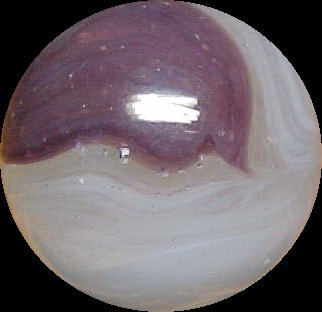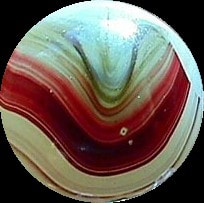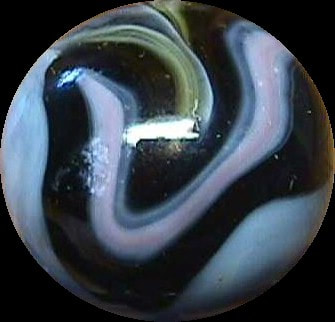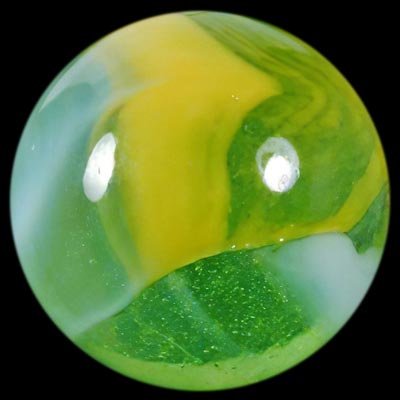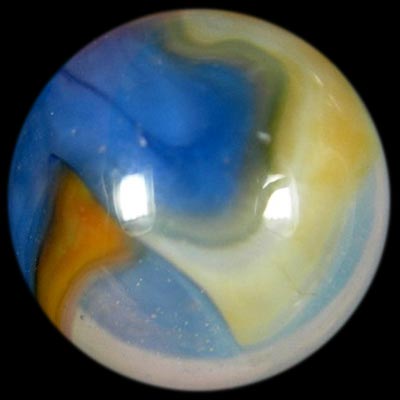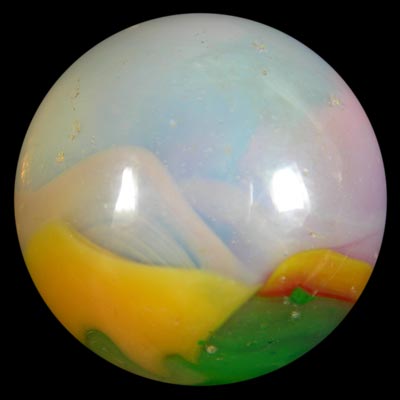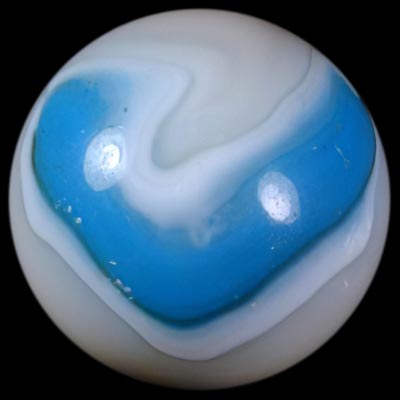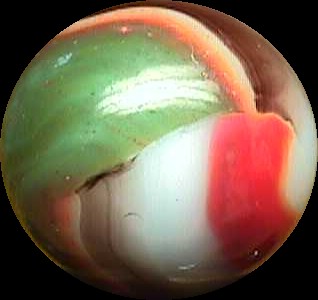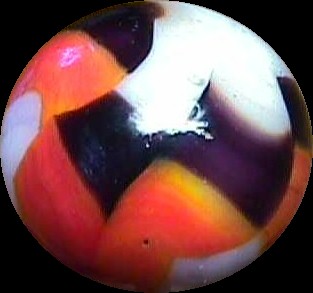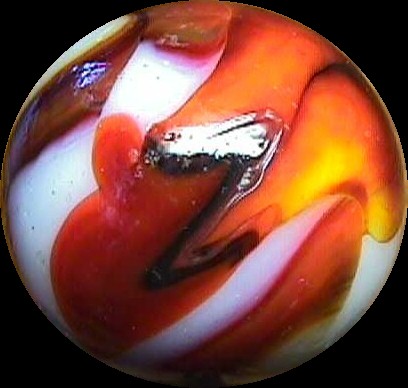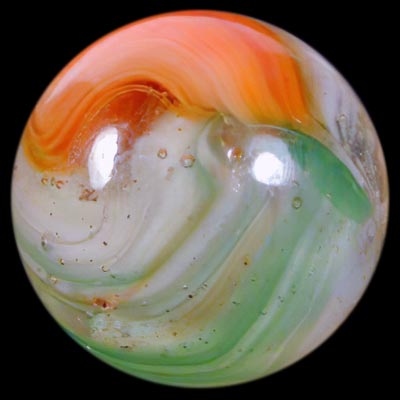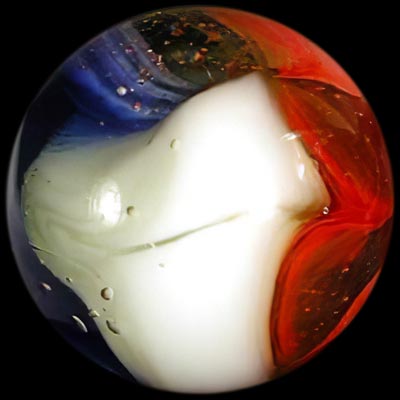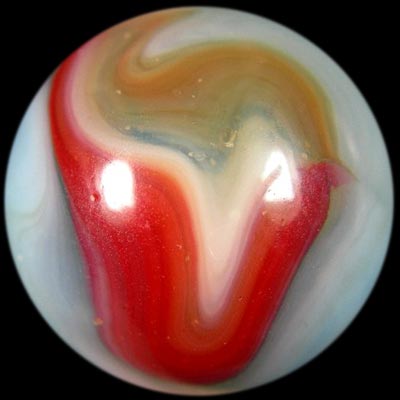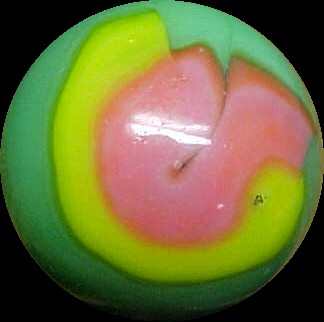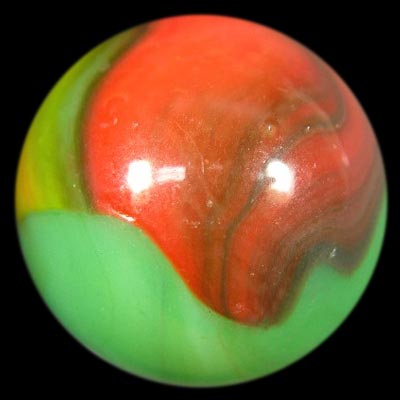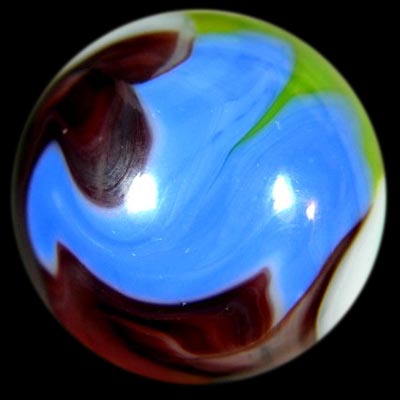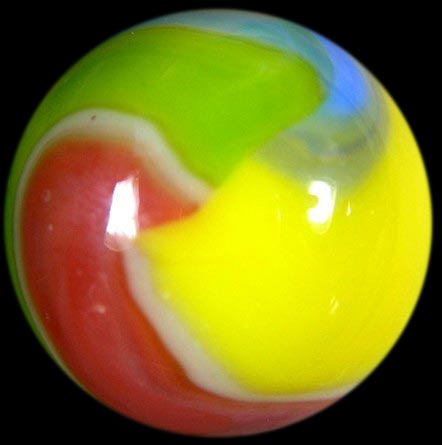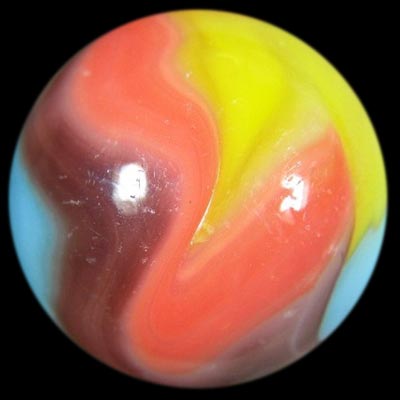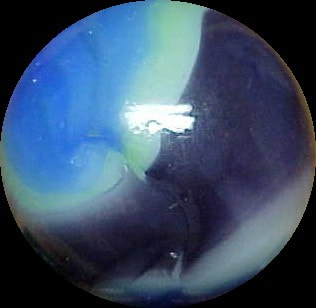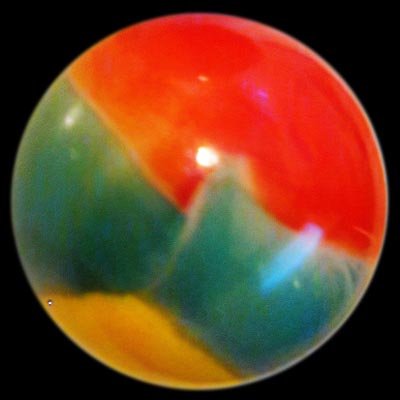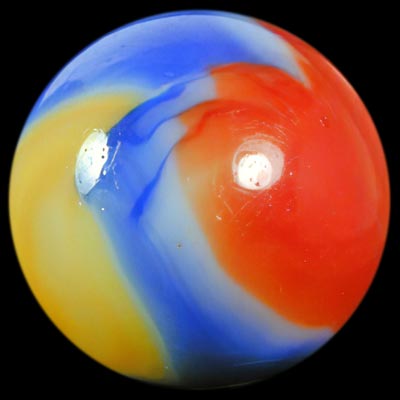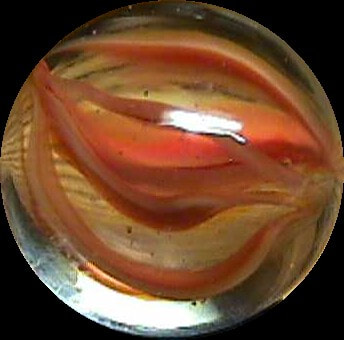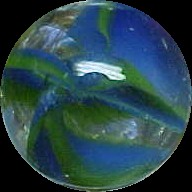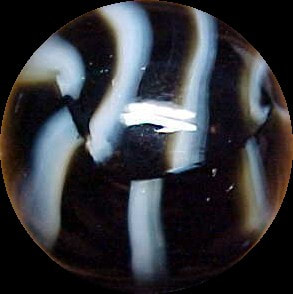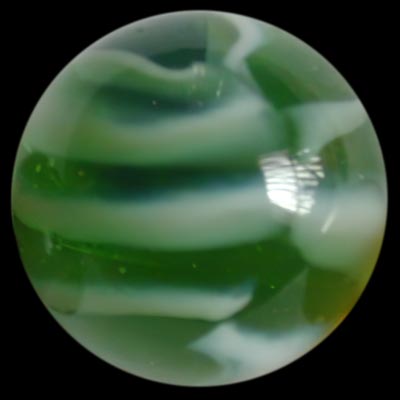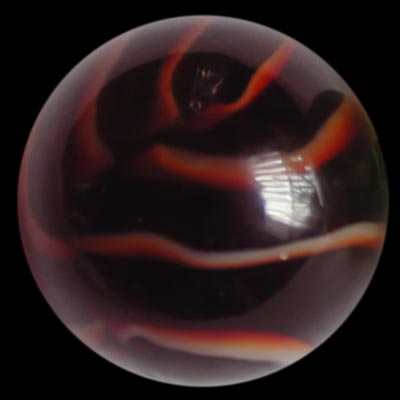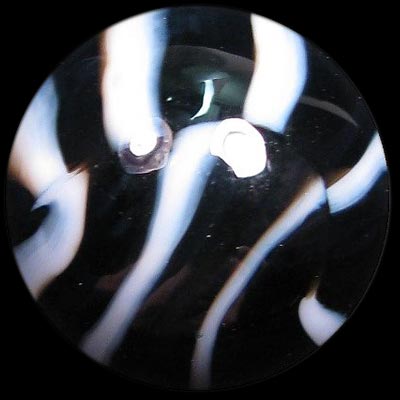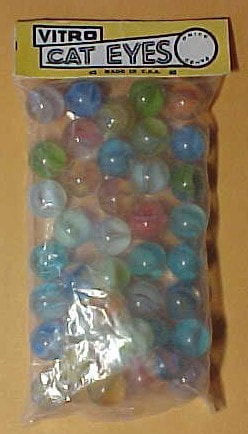VITRO AGATE COmpany (1932-1992)
COMPANY HISTORY
The Vitro Agate Company began in 1932 when the company was founded by Henri Arthur Fisher, Lawrence E. Alley, and Press Lindsey. It was moved to Parkersburg, West Virginia in 1945; Parkersburg had been used as a mailing address since the company's founding. In the late 1930s Alley sold his portion of the company to the other two and focused his attention on his Alley Agate Company (see Alley Agate page). Later on, Fisher bought out Lindsey and became the sole owner.
Vitro Agate was a strong contender in the marble market through the 1940s-1960s, being among the first of the American marble manufacturers to cash in on the craze for Japanese catseye marbles when the company developed its own in the mid-1950s. The knowledge for the manufacturing process of this particular marble style was obtained from Fisher's son, who had spent some time in the orient.
In 1969 Vitro Agate was purchased by the Gladding Corporation, who changed the company's name to Gladding-Vitro Agate. However, the original name was returned following the sale of the company to the Paris Manufacturing Company in 1982. Paris used Gladding label stock, however, until 1984, at which time they created their own labels. The following year Vitro Agate went bankrupt, only to be revitalized in September, 1987, when it was bought by Tim Sullivan and Dick Ryan of the Viking Rope Company for just over $360,000. Like the owners before them, they used their predecessors label stock before creating their own. In July of 1989 they moved the company to Anacortes, Washington.
Under the ownership of the Viking Rope Company, the name of the company became the Vitro Agate Corporation. In its Washington location, it was somewhat rejuvenated with the production of mostly game, decorative, and industrial marbles, though some marbles employing transparent and opaque swirls were produced in 1991. The company, however, went under in 1992 and was bought by Jabo, Inc. (see Jabo-Vitro Agate page).
The Vitro Agate Company began in 1932 when the company was founded by Henri Arthur Fisher, Lawrence E. Alley, and Press Lindsey. It was moved to Parkersburg, West Virginia in 1945; Parkersburg had been used as a mailing address since the company's founding. In the late 1930s Alley sold his portion of the company to the other two and focused his attention on his Alley Agate Company (see Alley Agate page). Later on, Fisher bought out Lindsey and became the sole owner.
Vitro Agate was a strong contender in the marble market through the 1940s-1960s, being among the first of the American marble manufacturers to cash in on the craze for Japanese catseye marbles when the company developed its own in the mid-1950s. The knowledge for the manufacturing process of this particular marble style was obtained from Fisher's son, who had spent some time in the orient.
In 1969 Vitro Agate was purchased by the Gladding Corporation, who changed the company's name to Gladding-Vitro Agate. However, the original name was returned following the sale of the company to the Paris Manufacturing Company in 1982. Paris used Gladding label stock, however, until 1984, at which time they created their own labels. The following year Vitro Agate went bankrupt, only to be revitalized in September, 1987, when it was bought by Tim Sullivan and Dick Ryan of the Viking Rope Company for just over $360,000. Like the owners before them, they used their predecessors label stock before creating their own. In July of 1989 they moved the company to Anacortes, Washington.
Under the ownership of the Viking Rope Company, the name of the company became the Vitro Agate Corporation. In its Washington location, it was somewhat rejuvenated with the production of mostly game, decorative, and industrial marbles, though some marbles employing transparent and opaque swirls were produced in 1991. The company, however, went under in 1992 and was bought by Jabo, Inc. (see Jabo-Vitro Agate page).
IDENTIFICATION TIPS
Most Vitro Agate marbles are patches, though other varieties were also produced. The styles changed over time, so it is fairly easy to approximate the ages of their marbles based on a number of attributes. Vitro Agate patches come in two main styles, identified by their seams. One style has seams that are straight and have palpable crimps into the glass. The other style has one straight seam and other that is shaped like a flattened "U." The seams on both styles are opposite one another on the equator and are perpendicular to the poles.
BRUSHED PATCHES / AQUA JEWELS
Brushed Patches are among Vitro Agate's oldest marbles. The base is either transparent clear or opaque white and has colors brushed on the surface. Some of these have oxblood; sometimes the oxblood is "anemic." It should be noted that Victories and Conquerors are types of brushed patches, but are discussed separately, below.
Aqua Jewels were Vitros line of Clearie marbles. They came in a variety of clear color based glass and were one of Vitro Agates best sellers.
VICTORIES & CONQUERORS
A Victory is a brushed patch marble that has an opaque color patch on a transparent clear base. This patch covers about one quarter of the marble and, like many Vitro marbles, the patch is usually shaped like an oval with a small "v" or "hook" coming off one end. A Conqueror is basically the same type of marble, but on this variety the remaining three-quarters of the marble not covered by the patch contains brushed opaque white. One variation of the Conqueror is the "phantom conqueror," or 'Opaque' which has translucent white filaments inside the marble. The glass may be opalescent on this latter type. Finally, another variation of the Conqueror has a dull patch as opposed to bright and brushed off-white as opposed to white. On these, the patch seems to often be shaped like a large "V." Victories and conquerors were distributed, as their names might imply, around the period of World War II.
Most Vitro Agate marbles are patches, though other varieties were also produced. The styles changed over time, so it is fairly easy to approximate the ages of their marbles based on a number of attributes. Vitro Agate patches come in two main styles, identified by their seams. One style has seams that are straight and have palpable crimps into the glass. The other style has one straight seam and other that is shaped like a flattened "U." The seams on both styles are opposite one another on the equator and are perpendicular to the poles.
BRUSHED PATCHES / AQUA JEWELS
Brushed Patches are among Vitro Agate's oldest marbles. The base is either transparent clear or opaque white and has colors brushed on the surface. Some of these have oxblood; sometimes the oxblood is "anemic." It should be noted that Victories and Conquerors are types of brushed patches, but are discussed separately, below.
Aqua Jewels were Vitros line of Clearie marbles. They came in a variety of clear color based glass and were one of Vitro Agates best sellers.
VICTORIES & CONQUERORS
A Victory is a brushed patch marble that has an opaque color patch on a transparent clear base. This patch covers about one quarter of the marble and, like many Vitro marbles, the patch is usually shaped like an oval with a small "v" or "hook" coming off one end. A Conqueror is basically the same type of marble, but on this variety the remaining three-quarters of the marble not covered by the patch contains brushed opaque white. One variation of the Conqueror is the "phantom conqueror," or 'Opaque' which has translucent white filaments inside the marble. The glass may be opalescent on this latter type. Finally, another variation of the Conqueror has a dull patch as opposed to bright and brushed off-white as opposed to white. On these, the patch seems to often be shaped like a large "V." Victories and conquerors were distributed, as their names might imply, around the period of World War II.
BRUSHED PATCHES, VICTORIES & CONQUERORS GALLERY
(Hover your mouse or lightly touch the image to see the type of marble. Click to view the full size image)
(Hover your mouse or lightly touch the image to see the type of marble. Click to view the full size image)
TRICOLOR & MULTICOLOR PATCHES
The Tricolored Patch (Tri-Lite) is a two-seam marble with a transparent clear base. All or nearly all of the surface is veneered with colored patches, always white in combination with three other colors such as light or dark blue, green, orange, yellow, or lavender. One pole will contain the characteristic football-shaped Vitro patch with the "hook" on one side. One side of the equator has a wide patch of a second color, while the other side will contain two thinner patches, one a third color and one white. The equatorial colors meet at the opposite pole. It also came in a two color known as a Du-Lite. Names for different styles of Tri-Lites from collectors include Superiors, Elites, Helmets, Aquamarines, Buttermilk's, Biscuits & Gravy to name a few.
The most common style of Vitro multicolor patches were All-Reds. A white opaque base with red on on one side and usually blue or green with brown on the other. Another popular type of patch marble is the Helmet. These often fluorescent marbles derive their name from the trait they have in which if the marble is viewed from a particular angle, the patch looks like a football helmet with a stripe down the middle. The stripe down the middle can come in a variety of colors.
The Tricolored Patch (Tri-Lite) is a two-seam marble with a transparent clear base. All or nearly all of the surface is veneered with colored patches, always white in combination with three other colors such as light or dark blue, green, orange, yellow, or lavender. One pole will contain the characteristic football-shaped Vitro patch with the "hook" on one side. One side of the equator has a wide patch of a second color, while the other side will contain two thinner patches, one a third color and one white. The equatorial colors meet at the opposite pole. It also came in a two color known as a Du-Lite. Names for different styles of Tri-Lites from collectors include Superiors, Elites, Helmets, Aquamarines, Buttermilk's, Biscuits & Gravy to name a few.
The most common style of Vitro multicolor patches were All-Reds. A white opaque base with red on on one side and usually blue or green with brown on the other. Another popular type of patch marble is the Helmet. These often fluorescent marbles derive their name from the trait they have in which if the marble is viewed from a particular angle, the patch looks like a football helmet with a stripe down the middle. The stripe down the middle can come in a variety of colors.
TRICOLOR & MULTICOLOR PATCHES GALLERY
(Hover your mouse or lightly touch the image to see the type of marble. Click to view the full size image)
(Hover your mouse or lightly touch the image to see the type of marble. Click to view the full size image)
PARROTS, SWEET PEA, BLACK EYED PEAS
Arguably the most popular Vitro Agate marble is the Parrot, so named because it usually contains four or more colors. These marbles are white-based and have colors brushed on the surface; sometimes one or more of these colors form a "V" and the better formed the more valuable the marble becomes. Common colors on a Parrot include red, lavender, yellow, green, black, and light blue, and sometimes different shades of one particular color. Sometimes the green patches will contain aventurine. Parrots tend to be large, at least 3/4" and up to 1". More recently, Vitro-Agate produced a smaller version containing many of the same colors but which are veneered. These have been dubbed "Parakeets" by some collectors.
Two green-based patches have been given names are very popular. The Sweet Pea has a green base with coral and yellow patches, and the Blackeyed Pea has a green base with yellow and black patches. These patches often form characteristic "V's" or "U's" and sometimes the green base will have aventurine.
Arguably the most popular Vitro Agate marble is the Parrot, so named because it usually contains four or more colors. These marbles are white-based and have colors brushed on the surface; sometimes one or more of these colors form a "V" and the better formed the more valuable the marble becomes. Common colors on a Parrot include red, lavender, yellow, green, black, and light blue, and sometimes different shades of one particular color. Sometimes the green patches will contain aventurine. Parrots tend to be large, at least 3/4" and up to 1". More recently, Vitro-Agate produced a smaller version containing many of the same colors but which are veneered. These have been dubbed "Parakeets" by some collectors.
Two green-based patches have been given names are very popular. The Sweet Pea has a green base with coral and yellow patches, and the Blackeyed Pea has a green base with yellow and black patches. These patches often form characteristic "V's" or "U's" and sometimes the green base will have aventurine.
PARROTS, SWEET PEA & BLACK EYED PEA GALLERY
(Hover your mouse or lightly touch the image to see the type of marble. Click to view the full size image)
(Hover your mouse or lightly touch the image to see the type of marble. Click to view the full size image)
TIGER EYES, BLACKIES, WHITIES, YELLOW JACKETS
In addition to the aforementioned patch style marbles, Vitro produced many more over the years. Starting in the late 1950s into the 1960s, a new style of patch referred to in advertising as Blackies, Whities and Yellow Jackets were released. Whities had an opaque white base glass with a ribbon of color around the middle of the marble. The Blackies had an opaque base glass usually green, red, yellow or blue with a black patch on the poles. A 'reverse blackie' (collector name) was also released that had the black ribbon around the middle with the opaque patches on the poles.
Yellow Jackets were a white base glass marble with three colors. Bright yellow was always on one side, a black, blue, white or green ribbon around the middle and bright red on the other side.
Tiger Eyes were a three color veneered patch over a clear base glass. These came in many different styles and color combinations and have been broken down into four types by collectors.
Type I - Color patch on top with a two color (seam to seam) ribbon in the middle
Type II - Color patch on top with a different color patch on the bottom and a single color ribbon in the middle (no white)
Type III - Color patch on top with a different color patch on the bottom and a single white ribbon in the middle
Type IV - White opaque base glass with a color patch on top and a different color patch on the bottom
In addition to the aforementioned patch style marbles, Vitro produced many more over the years. Starting in the late 1950s into the 1960s, a new style of patch referred to in advertising as Blackies, Whities and Yellow Jackets were released. Whities had an opaque white base glass with a ribbon of color around the middle of the marble. The Blackies had an opaque base glass usually green, red, yellow or blue with a black patch on the poles. A 'reverse blackie' (collector name) was also released that had the black ribbon around the middle with the opaque patches on the poles.
Yellow Jackets were a white base glass marble with three colors. Bright yellow was always on one side, a black, blue, white or green ribbon around the middle and bright red on the other side.
Tiger Eyes were a three color veneered patch over a clear base glass. These came in many different styles and color combinations and have been broken down into four types by collectors.
Type I - Color patch on top with a two color (seam to seam) ribbon in the middle
Type II - Color patch on top with a different color patch on the bottom and a single color ribbon in the middle (no white)
Type III - Color patch on top with a different color patch on the bottom and a single white ribbon in the middle
Type IV - White opaque base glass with a color patch on top and a different color patch on the bottom
TIGER EYES, BLACKIES, WHITIES, YELLOW JACKETS GALLERY
(Hover your mouse or lightly touch the image to see the type of marble. Click to view the full size image)
(Hover your mouse or lightly touch the image to see the type of marble. Click to view the full size image)







